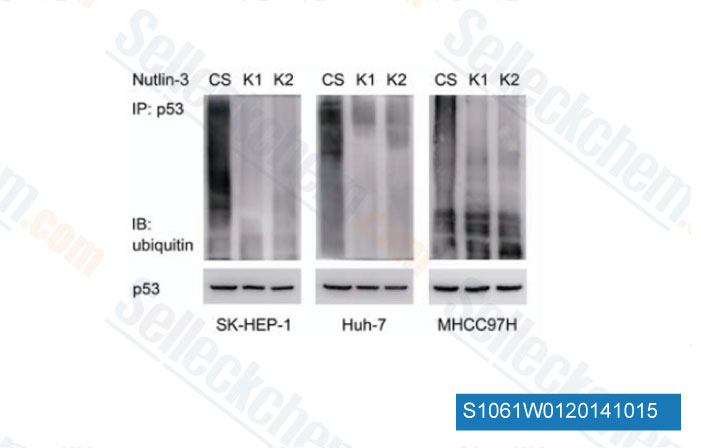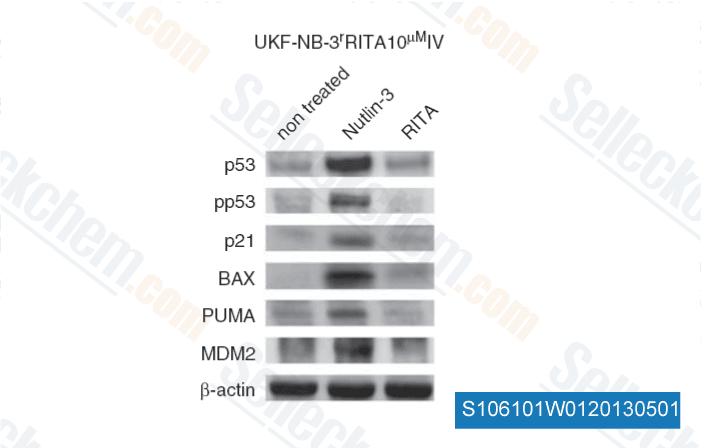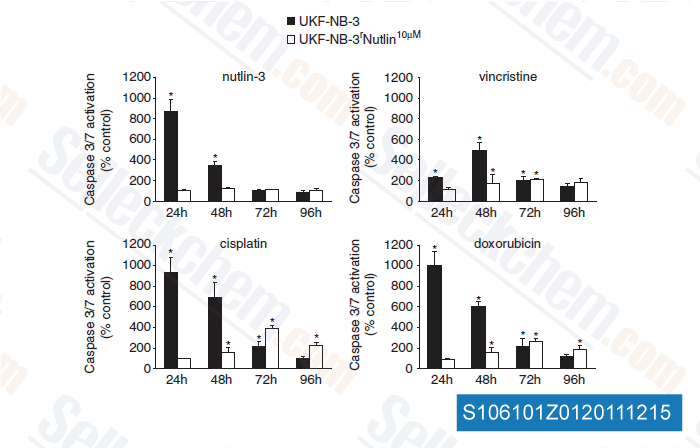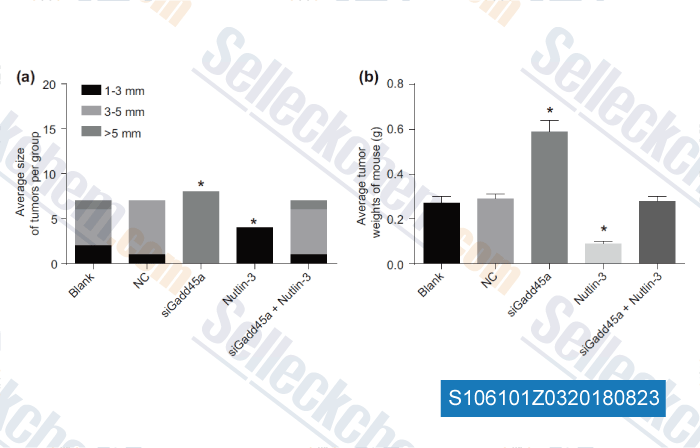|
Toll Free: (877) 796-6397 -- USA and Canada only -- |
Fax: +1-832-582-8590 Orders: +1-832-582-8158 |
Tech Support: +1-832-582-8158 Ext:3 Please provide your Order Number in the email. |
Technical Data
| Formula | C30H30Cl2N4O4 |
||||||
| Molecular Weight | 581.5 | CAS No. | 890090-75-2 | ||||
| Solubility (25°C)* | In vitro | DMSO | 100 mg/mL (171.96 mM) | ||||
| Ethanol | 100 mg/mL (171.96 mM) | ||||||
| Water | Insoluble | ||||||
| In vivo (Add solvents to the product individually and in order) |
|
||||||
|
* <1 mg/ml means slightly soluble or insoluble. * Please note that Selleck tests the solubility of all compounds in-house, and the actual solubility may differ slightly from published values. This is normal and is due to slight batch-to-batch variations. * Room temperature shipping (Stability testing shows this product can be shipped without any cooling measures.) |
|||||||
Preparing Stock Solutions
Biological Activity
| Description | Nutlin-3 is a potent and selective Mdm2 (RING finger-dependent ubiquitin protein ligase for itself and p53) antagonist with IC50 of 90 nM in a cell-free assay; stabilizes p73 in p53-deficient cells. | ||
|---|---|---|---|
| Targets |
|
||
| In vitro | Nutlin-3 potently inhibits the MDM2-p53 interaction, leading to the activation of the p53 pathway. This compound treatment induces the expression of MDM2 and p21, and displays potent antiproliferative activity with IC50 of ~1.5 μM, only in cells with wild-type p53 such as HCT116, RKO and SJSA-1, but not in the mutant p53 cell lines SW480 and MDA-MB-435. In SJSA-1 cells, this compound treatment at 10 μM for 48 hours significantly induces caspase-dependent cell apoptosis by ~45%. Although it also inhibits the growth and viability of human skin (1043SK) and mouse embryo (NIH/3T3) with IC50 of 2.2 μM and 1.3 μM, respectively, cells remain viable 1 week post-treatment even at 10 μM of this chemical, in contrast with the SJSA-1 cells with viability lost at 3 μM of this chemical treatment. [1] It does not induce the phosphorylation of p53 on key serine residues and reveals no difference in their sequence-specific DNA binding and ability to transactivate p53 target genes compared with phosphorylated p53 induced by the genotoxic drugs doxorubicin, demonstrating that phosphorylation of p53 on key serines is dispensable for transcriptional activation and apoptosis. [2] Although binding less efficiently to MDMX than to MDM2, this compound can block the MDMX–p53 interaction and induce the p53 pathway in retinoblastoma cells (Weri1) with IC50 of 0.7 μM. [3] This chemical at 30 μM also disrupts endogenous p73-HDM2 interaction and enhances the stability and proapoptotic activities of p73, leading to the dose-dependent cell growth inhibition and apoptosis induction in cells without wild-type p53. [4] |
||
| In vivo | Oral administration of Nutlin-3 at 200 mg/kg twice daily for 3 weeks significantly inhibits the tumor growth of SJAS-1 xenografts by 90%, comparable with the effect of doxorubicin treatment with 81% inhibition of tumor growth. [1] |
Protocol (from reference)
| Kinase Assay: |
|
|---|---|
| Cell Assay: |
|
| Animal Study: |
|
References
|
Customer Product Validation

-
Data from [ Int J Oncol , 2014 , 44, 761-8 ]

-
Data from [ Cell Death Dis , 2012 , 3, e294 ]

-
Data from [ Cell Death Dis , 2011 , 2, e243 ]

-
Data from [ , , J Cell Physiol, 2018, 233(9):7424-7434 ]
Selleck's Nutlin-3 Has Been Cited by 114 Publications
| Disparate Pathways for Extrachromosomal DNA Biogenesis and Genomic DNA Repair [ Cancer Discov, 2025, 15(1):69-82] | PubMed: 39109936 |
| MDM2 inhibitors induce apoptosis by suppressing MDM2 and enhancing p53, Bax, Puma and Noxa expression levels in imatinib‑resistant chronic myeloid leukemia cells [ Biomed Rep, 2025, 22(4):65] | PubMed: 39991005 |
| Alanyl-tRNA synthetase, AARS1, is a lactate sensor and lactyltransferase that lactylates p53 and contributes to tumorigenesis [ Cell, 2024, 187(10):2375-2392.e33] | PubMed: 38653238 |
| High-throughput evaluation of genetic variants with prime editing sensor libraries [ Nat Biotechnol, 2024, 10.1038/s41587-024-02172-9] | PubMed: 38472508 |
| A homoeostatic switch causing glycerol-3-phosphate and phosphoethanolamine accumulation triggers senescence by rewiring lipid metabolism [ Nat Metab, 2024, 6(2):323-342] | PubMed: 38409325 |
| Decreased plasma gelsolin fosters a fibrotic tumor microenvironment and promotes chemoradiotherapy resistance in esophageal squamous cell carcinoma [ J Biomed Sci, 2024, 31(1):90] | PubMed: 39261905 |
| Multiomics analyses reveal adipose-derived stem cells inhibit the inflammatory response of M1-like macrophages through secreting lactate [ Stem Cell Res Ther, 2024, 15(1):485] | PubMed: 39696485 |
| A CRISPR/Cas9 screen in embryonic stem cells reveals that Mdm2 regulates totipotency exit [ Commun Biol, 2024, 7(1):809] | PubMed: 38961268 |
| NEK2 promotes TP53 ubiquitination to enhance the proliferation and migration of TP53 wild-type glioblastoma cells [ Neoplasma, 2024, 71(3):255-265] | PubMed: 38764296 |
| MYC and p53 alterations cooperate through VEGF signaling to repress cytotoxic T cell and immunotherapy responses in prostate cancer [ bioRxiv, 2024, 2024.07.24.604943] | PubMed: 39091883 |
RETURN POLICY
Selleck Chemical’s Unconditional Return Policy ensures a smooth online shopping experience for our customers. If you are in any way unsatisfied with your purchase, you may return any item(s) within 7 days of receiving it. In the event of product quality issues, either protocol related or product related problems, you may return any item(s) within 365 days from the original purchase date. Please follow the instructions below when returning products.
SHIPPING AND STORAGE
Selleck products are transported at room temperature. If you receive the product at room temperature, please rest assured, the Selleck Quality Inspection Department has conducted experiments to verify that the normal temperature placement of one month will not affect the biological activity of powder products. After collecting, please store the product according to the requirements described in the datasheet. Most Selleck products are stable under the recommended conditions.
NOT FOR HUMAN, VETERINARY DIAGNOSTIC OR THERAPEUTIC USE.
